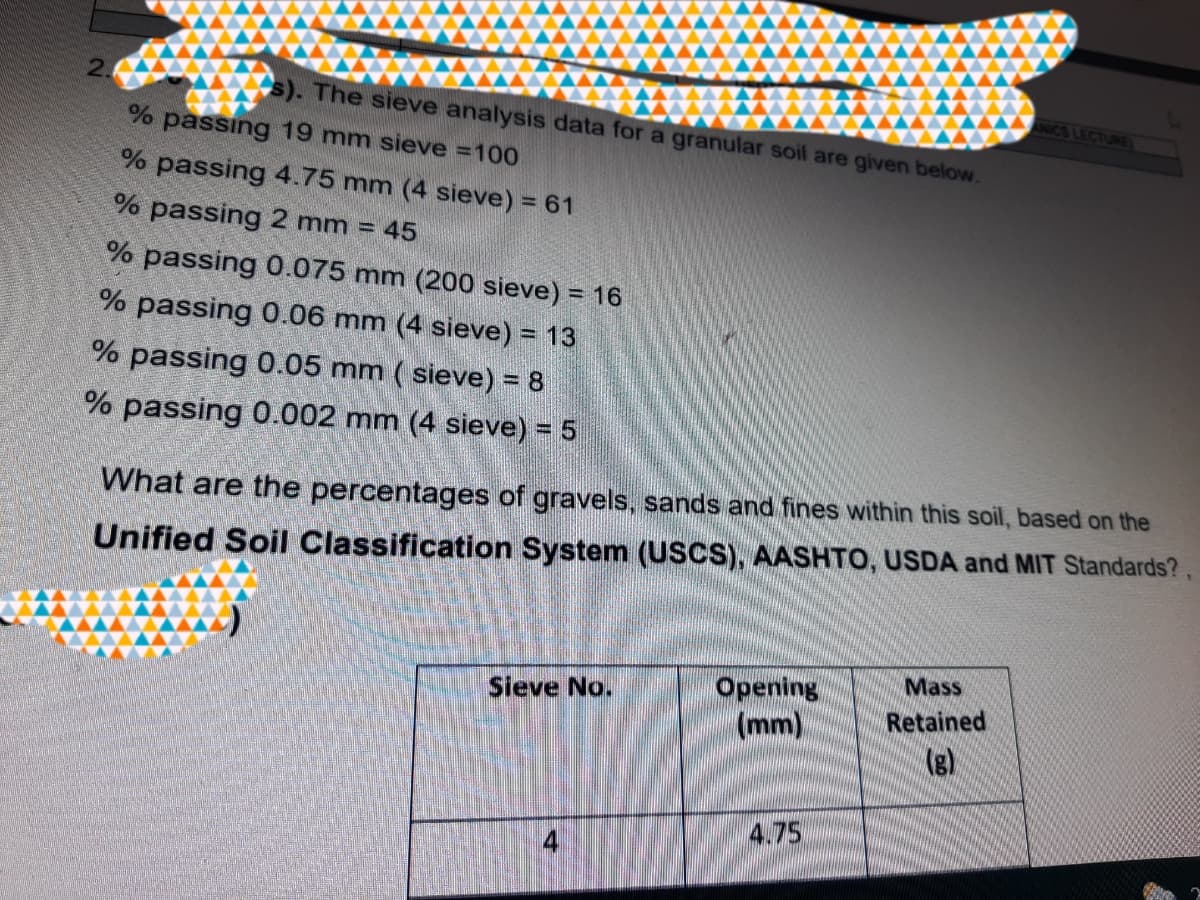The sieve analysis data for a granular soil are given below. NES LECTUREY % passing 19 mm sieve =100 % passing 4.75 mm (4 sieve) = 61 % passing 2 mm = 45 % passing 0.075 mm (200 sieve) = 16 % passing 0.06 mm (4 sieve) = 13 % passing 0.05 mm ( sieve) = 8 % passing 0.002 mm (4 sieve) = 5 What are the percentages of gravels, sands and fines within this soil, based on the Unified Soil Classification System (USCS), AASHTO, USDA and MIT Standards? Mass Opening (mm) Sieve No. Retained (g) 4.75 4
The sieve analysis data for a granular soil are given below. NES LECTUREY % passing 19 mm sieve =100 % passing 4.75 mm (4 sieve) = 61 % passing 2 mm = 45 % passing 0.075 mm (200 sieve) = 16 % passing 0.06 mm (4 sieve) = 13 % passing 0.05 mm ( sieve) = 8 % passing 0.002 mm (4 sieve) = 5 What are the percentages of gravels, sands and fines within this soil, based on the Unified Soil Classification System (USCS), AASHTO, USDA and MIT Standards? Mass Opening (mm) Sieve No. Retained (g) 4.75 4
Fundamentals of Geotechnical Engineering (MindTap Course List)
5th Edition
ISBN:9781305635180
Author:Braja M. Das, Nagaratnam Sivakugan
Publisher:Braja M. Das, Nagaratnam Sivakugan
Chapter2: Soil Deposits-origin, Grain-size, And Shape
Section: Chapter Questions
Problem 2.4P: For a soil, given: D10 = 0.08 mm D30 = 0.22 mm D60 = 0.41 mm Calculate the uniformity coefficient...
Related questions
Question

Transcribed Image Text:2.
The sieve analysis data for a granular soil are given below.
NICS LECTUREY
% passing 19 mm sieve =100
% passing 4.75 mm (4 sieve) = 61
% passing 2 mm = 45
% passing 0.075 mm (200 sieve) = 16
%3D
% passing 0.06 mm (4 sieve) = 13
% passing 0.05 mm ( sieve) = 8
% passing 0.002 mm (4 sieve) = 5
What are the percentages of gravels, sands and fines within this soil, based on the
Unified Soil Classification System (USCS), AASHTO, USDA and MIT Standards?
Mass
Opening
(mm)
Sieve No.
Retained
(g)
4.75
4
Expert Solution
This question has been solved!
Explore an expertly crafted, step-by-step solution for a thorough understanding of key concepts.
This is a popular solution!
Trending now
This is a popular solution!
Step by step
Solved in 4 steps with 3 images

Knowledge Booster
Learn more about
Need a deep-dive on the concept behind this application? Look no further. Learn more about this topic, civil-engineering and related others by exploring similar questions and additional content below.Recommended textbooks for you

Fundamentals of Geotechnical Engineering (MindTap…
Civil Engineering
ISBN:
9781305635180
Author:
Braja M. Das, Nagaratnam Sivakugan
Publisher:
Cengage Learning

Fundamentals of Geotechnical Engineering (MindTap…
Civil Engineering
ISBN:
9781305635180
Author:
Braja M. Das, Nagaratnam Sivakugan
Publisher:
Cengage Learning